
On paper, rock climbing sounds quite simple – climb up a rock face either with or without ropes and safety gear. And yet, there are so many different terms used in the climbing community to describe all sorts of different features to rock climbing.
During your time rock climbing you’ll be hearing a few terms that you may not understand at first but eventually you’ll catch on. However there might be that rock climbing term that seems to be passed around every now and then and you still wonder what it means. Well in this article I’ve got a list of 217 terms used when rock climbing including their definitions. I’ve also tried to include pictures/images where I can.
If you need to find a specific term on this page then press Ctrl+F if you’re on a PC or Command+F on a Mac to open up the “Find” tool. If you’re on a mobile device you can usually use the same sort of tool (it may be called “Find in page” or “Find on page”) on your web browser by searching through the options usually indicated by three vertical dots in the top right or left of your screen.
Page Jumps
- Rock Climbing Terms for Ascents
- Rock Climbing Terms for Holds
- Rock Climbing Terms for Moves
- Rock Climbing Terms for Equipment
- Observational and Other Rock Climbing Terms
- Terms Used for Different Types of Rock Climbing
- Terms for Different Types of Rock Used When Climbing
Rock Climbing Terms for Ascents
Beta aka Sequence
The supposed “right way” to ascend a climbing route.
Flash aka On Sight
Climbing a route on your first attempt without beta.
Beta flash
Completing a climb on the first attempt with the supposed “right way” of ascending the route.
Top Out
Reaching the end of a bouldering problem and standing up on top of it. This usually happens outside or on specific top out boulders indoors.
Top Rope
Creating some form of anchor at the top of a climb for a rope to attach to so that climbers are safe.
Slab
An incline that isn’t as steep as a vertical climb. The angle is less than 90 degrees.
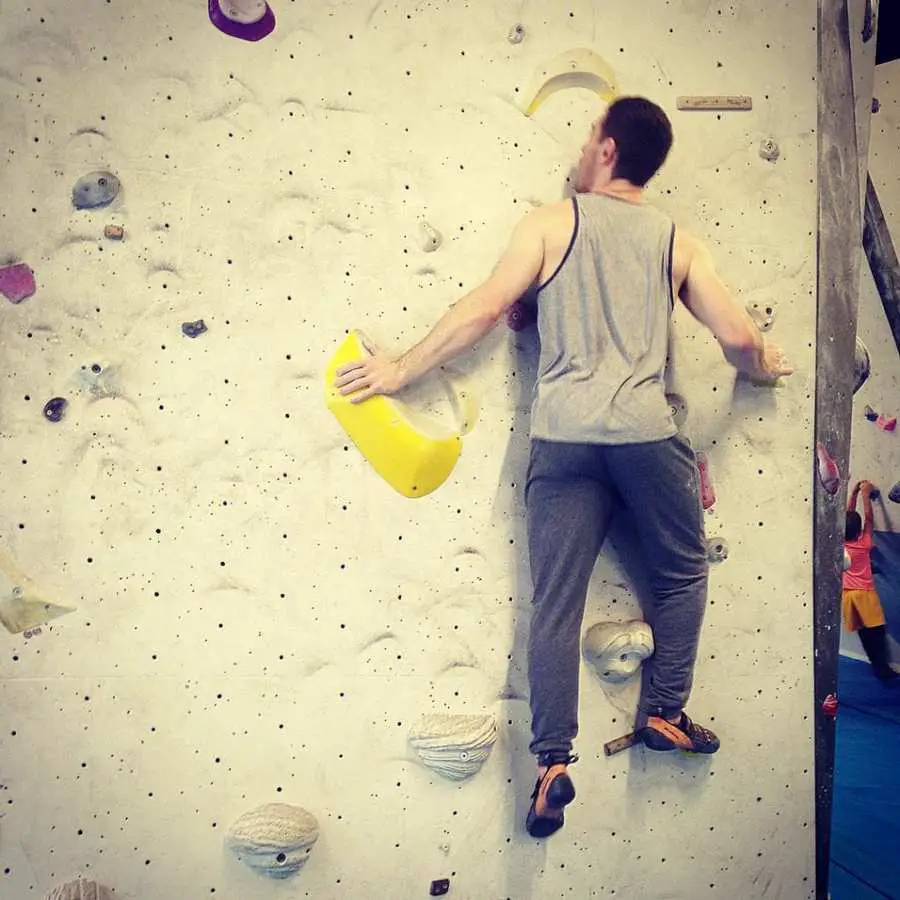
Overhang
A decline that is angled more than 90 degrees.

Roof
A climb on a virtually horizontal climbing wall.
Overlap
A small-ish roof.

Vertical Climb
A climbing wall that’s pretty much 90 degrees straight up.
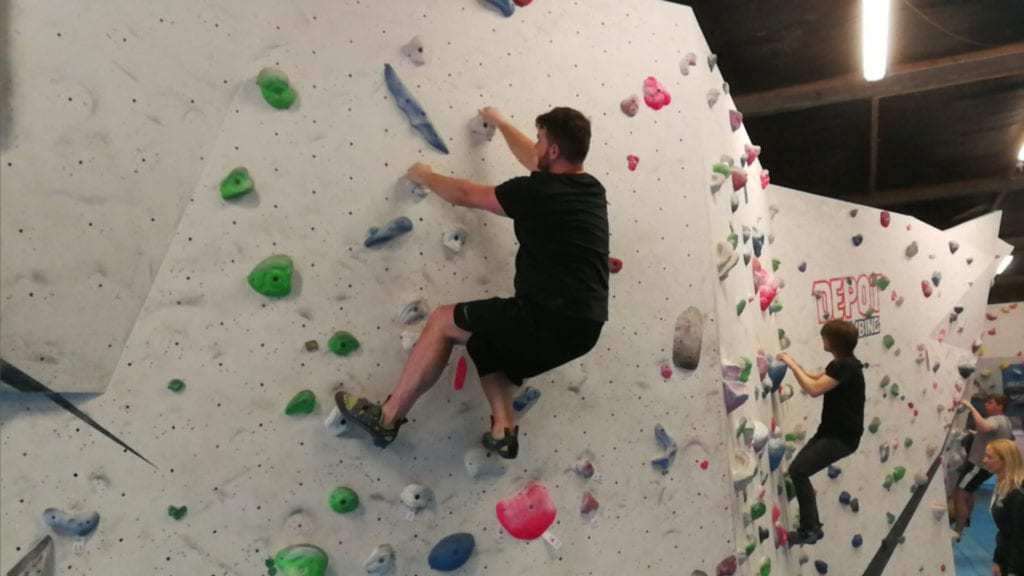
Traverse
A climb that requires you to transition mostly sideways.
Circuit Board aka Systems Board
A vertical climb or overhang that includes many different types of holds laid out in a circular pattern so the climber can train endurance, grip work, and general technique.
Training Board aka Woodie
Usually an overhang that consists of many holds, usually with the intention for the climber to make up their own climbs suitable to their grade.
Lowball
A bouldering problem which is quite short or low.
Ground Up
Requires, generally, that you use a sit down start so that you a climbing a route from the ground.
Morpho
A route that is difficult for someone because of their body weight, shape, height and/or size. For example the route may be harder for a short person to complete than a taller person.
Buttress
Prominent rock bulging out from a rock climbing wall.
Groove
A small corner.
Chimney
A part of the rock that is a hole big enough to fit your whole body in.
Descent Route
The best way to get down from a bouldering problem.
Landing Zone aka Fall Zone
The area in which a climber can land or fall into from a bouldering problem.
Down Climbing
Climbing down a bouldering problem.
Redpoint
Climb a route without aid (free-climbing) successfully without falling having already climbed it unsuccessfully.
Headpoint
Climb a route after you have the tried it beforehand using a top rope.
Deadpoint
A dynamic move that’s been doing in a controlled fashion. It involves grabbing a hold at the top of the body while moving – at least one foot and the other hand remain on the wall. Other dynamic movements such as dynos involve both feet leaving the wall to catch or fall into another hold.
Bulge
An overhang with a rounded edge.
Barrel
A rounded roof.
Arête/Arete
The edge of a mountain or boulder. Where two sides of a mountain or boulder meet. The arête is used often in bouldering and can be one of the easiest things to grab when on a route.
Prow
An overhanging arete.
Buildering
Bouldering on buildings. It’s the combination of the words bouldering and building.
First Ascent
The first ever time a route is climbed. This can be in general or for a specific climber.
Corner
The opposite of an arête. Where two sides,walls or edges meet.
Campus Board
A board that is usually vertical or on a slight overhang with wooden slats of different sizes. The purpose is to use no feet therefore strengthening the arms and fingers by jumping up the slats and climbing back down.
Feature Wall
An indoor wall that is designed to resemble real rock.
An artificial wall usually found in climbing gyms to mimic the look of an outdoor climb.
Rock Climbing Terms for Holds
Bucket aka Jug
An easily grabbed hold which contains a dip in the center.
Edge
A hold usually used by the feet which has a straight top pretty much parallel with the floor.
A hand or foot hold that contains a small hole or space.
Crack
A line on the rock which has split. Crack climbing is quite popular.
Sloper
Rounded holds without any proper edge to grip.
Crimp
An edge that requires you to use the end of your fingers to grip onto it.
Volume
An artificial part of the wall that is usually the shape of a tetrahedron (3D triangle) or similar. Other holds can be mounted onto volumes, or volumes can be used as universal foot and hand holds on their own if they’re good enough.
Break
A crack that can be more circular than usual and is parallel to the floor.
Chicken Head aka Boss
A lump of rock bulging out from the wall commonly used as an anchor or as a hand/foot hold. Is called a boss if it is particularly good as a hand hold.
Flake
A partly removed, thin sliver of rock.
Undercling aka Undercut
A hold that faces towards the floor that usually requires you pull up on it to stabilize yourself.
Dual-Tex / Dual-Tec
An artificial hold designed to be slippery for the feet and hands on the majority of it and have slight friction on another part to be used be the climber. Simply means dual texture.
Hueco
Exactly the same as a pocket but large and rounded.
Slot
A small pocket parallel to the floor.
Mono
A pocket that only has enough room for one finger.
Volcano Pocket
A hold that looks like a miniature volcano protruding from the wall.
Offwidth Crack
A crack that cannot be climbed inside as it is too narrow, however it cannot be jammed because it’s too wide.
Seam
A very narrow crack that is virtually shut.
Splitter
A long, vertical crack on a rock face.
P.O.S
Usually used when a climber isn’t very happy with a hand or foot hold. An abbreviation for “Piece of s***”.
Rock Climbing Terms for Moves
Dyno
A dynamic move that is typically used when a climber transitions from one set of holds (or one hold) to another set of holds (or one hold). This is done by jumping and both feet leave the wall to catch or fall into another hold.
Double Dyno
A type of dyno where one or more holds are grabbed at the same time by both of the climbers hands.
Half Crimp
A combination of crimping and using an open hand on a hold.
Matching aka Sharing
A technique used usually on bigger holds where the climber puts both hands simultaneously on one hold.
Gaston
Using a push rather than a pull motion, it’s a shoulder move, usually with the elbow out and thumb down. Imagine trying to open an elevator door. The hold is facing towards you and you utilize the shoulder.
Pinch
A sort of nipping technique on a hold with the thumb and fingers.
Sidepull
Similar to a Gaston however instead of a pushing motion, you pull. Gastons push away, sidepulls pull inward.
Hand Jam
Putting your hand in a crack to stop yourself from falling by packing it in there as much as you can. It can be quite painful.
Heel-toe Jam
Used in wide cracks where your foot is placed horizontally with your toe on one side and the heel on the other.
Hand Stacking
Hand jamming with both hands at the same time. Usually used in offwidth cracks.
Guppy aka Cup
A hold poking out of the wall is grasped by the palm and fingers.
Flag
The climber will use their leg to help them keep their center of gravity by free-hanging the foot.
Flared
A difficult to jam crack because the sides open up outwards.
Layback
This technique is done by pushing the feet into the wall, laying back a bit, and using the arms to pull into the hold.
Mantle
A technique that involves pulling on the hold and then as you transition it turns into a pushing motion.
Palming
Pushing down with the palm of your hand onto a rock on hold.
Figure Four
A technique used by more advanced climbers where a leg is used to hook over the arm that is grabbing onto a hold.
Rock-over
Shifting your center of gravity from one foot over towards to other by stepping on a high-ish foothold and transferring your weight over it onto your next set of holds.
Back and Foot
Placing the back on one side of a chimney and the feet push against the other side.
Stemming
Using both your feet to push on one side of a wall and both of your hands to push on the other.
Jamming
Packing a body part such as a foot or hand into a crack.
Edging
Putting your foot on an edge hold.
Finger Jam
Packing your fingers into a crack and rotating them until they become jammed into it.
Fist Jam
Putting your fist into a crack until it wedges itself in there.
Arm Bar
Putting an arm into a crack and pushing against one wall with your palm. The top of the arm pushes against the other wall.
Front Pointing
Using a big toe to stand on a hold.
Open Hand
Very slightly bending the fingers when gripping a hold.
Thumbcatch
Using the thumb to pinch the bottom of a hold.
Cross Through
A move where a hand will move above or below the other arm or hand to find the next hold.
Lock Off
Pulling on a hold until the arm bends, holding the position and then using the other hand to reach for the next hold.
Opposition
Creating tension either by pulling a pair of holds that face away from each other or pushing on a pair of holds that face each other.
Using two holds by either pulling on them if they face away from one another or by pushing on them if they face one another.
Bridging
Step on two different holds or smears on different wall angles and lean into the wall. This is a climbing technique used to climb corners and chimneys.
Drop-Knee aka Egyptian
Pull your body into the wall while twisting your foot and leg then dropping the knee.
Cutting Loose
Swinging both feet off the wall for a second or two, meaning all the weight is on the hands and arms in that time.
Bicycle
Used generally for roof climbing. Making use of two close together holds. One foot toe hooks a hold while the other foot pushes down on the other hold.
Frogging
Point the knees out to the side while getting the hips parallel and close to the wall.
Twist-locking
Twisting the top half of the body towards the wall to get maximum reach for the next hold.
Deadhang
Hanging on one or more holds with straight arms without using the feet.
No Hands Rest
Finding a position to rest so you don’t have to use your hands or arms.
Smear
Placing your shoe onto the wall for friction. Usually this is used when there are no foot holds available.
Chicken Wing
Jamming yourself into a crack by bending the arm and inserting the elbow while pressing the palm against one wall and pressing the top of the arms against the other. Quite similar to an arm bar.
Bump
Using one hold to gain more momentum to another hold by grabbing it with one hand and using the same hand to instantly grab the next hold.
Toe Hook
Used generally in roof climbing and on overhangs. Placing the toe behind a hold and pulling your foot towards you to gain strength on the hold.
Sprag
Used usually on an arête. The fingers grab a hold on one side of the arête while the thumb grabs a hold on the other side.
Backstep
One side of the hip is closer to the wall than the other, and the knees point in the same lateral direction. This can turn into a drop knee if the climber decides they need to.
Belaying
Releasing or gathering in the rope while another climber climbs.
Campusing
No feet allowed. Can only be done roof climbing and on overhangs. Using no feet on slabs is pretty hard.
Jump
Both feet leave the wall.
Jump Start
Jumping from the ground to the starting holds of a problem. It is done on a problem in which the climb cannot be started in any other way.
French Start
Slightly different to the jump start. French starts can often be climbs that can be started in many ways but the French start is finding the easiest way to start a climb while including a sort of jump or swing. Usually there is a hand and toe on the wall and you use the foot to jump or swing to the next hand or foothold. This is frowned upon in many climbing circles but is apparently considered fine at Fontainebleu.
Run and Jump
A dynamic technique that involves running at the rock, kicking off one or more foot holds and jumping for the hand holds.
Heel Hook
Using your heel on a hold to pull your body towards the next hold, or it’s used to hold yourself in a position.
Foot Cam
Wedging the foot in a horizontal crack by rotating it.
Foot Jam
Putting your foot into a crack, toes first and wedging it in.
Foot Swap
Substituting one foot on a foothold for another.
Kipping
Using the legs to generate momentum by kicking them while hanging from the arms.
Kneebars
Using the knee or top of the thigh to push into a part of the wall while putting your foot on a hold.
Rock Climbing Terms for Equipment
Protection
The general term for nuts, cams, and the equipment the rope is clipped on for safety.
Rack
The protective equipment for an individual climber.
Climbing Brush
A brush used to clean holds usually covered in chalk that’s causing them to become slippery.
In situ
Means in the appropriate place – usually explaining equipment left in climbs like pegs.
Quickdraw aka Extender
A couple of carabiners connected to each other by a strong material which can be clipped onto the rope for safety.
Climbing Shoes
Shoes created for the purpose of rock climbing.
Lace Ups
Climbing shoes that are fastened with laces.
Velcros
Climbing shoes that are fastened with velcro straps.
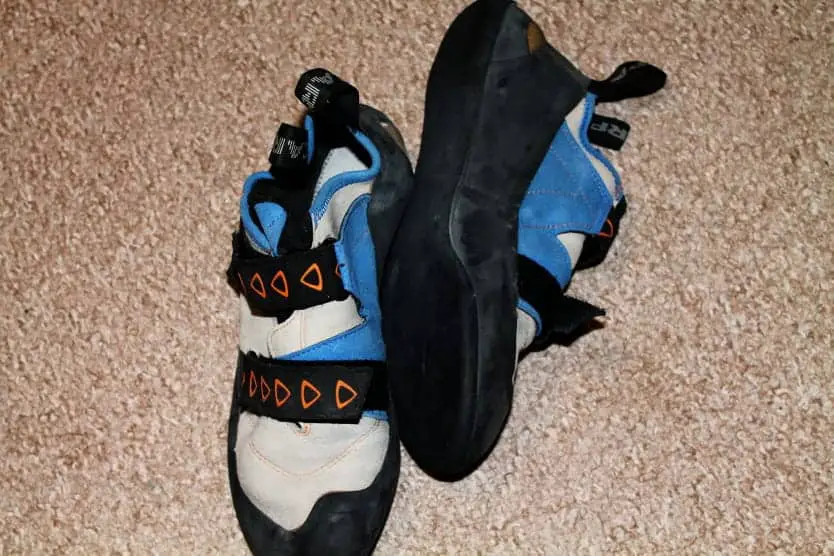
Slippers
Soft climbing shoes with no straps or laces.
Climbing Chalk
Climbing chalk is magnesium carbonate. It is used to absorb moisture from a climber’s hands so their hands are less likely to slip off a hold.
Liquid Chalk
Chalk mixed with alcohol as an alternative to normal chalk. Preferable when deep water soloing.
Chalk Bag
A small bag for holding chalk that can be attached to a belt.
Chalk Bucket
A large bag for holding chalk which should be left on the ground.
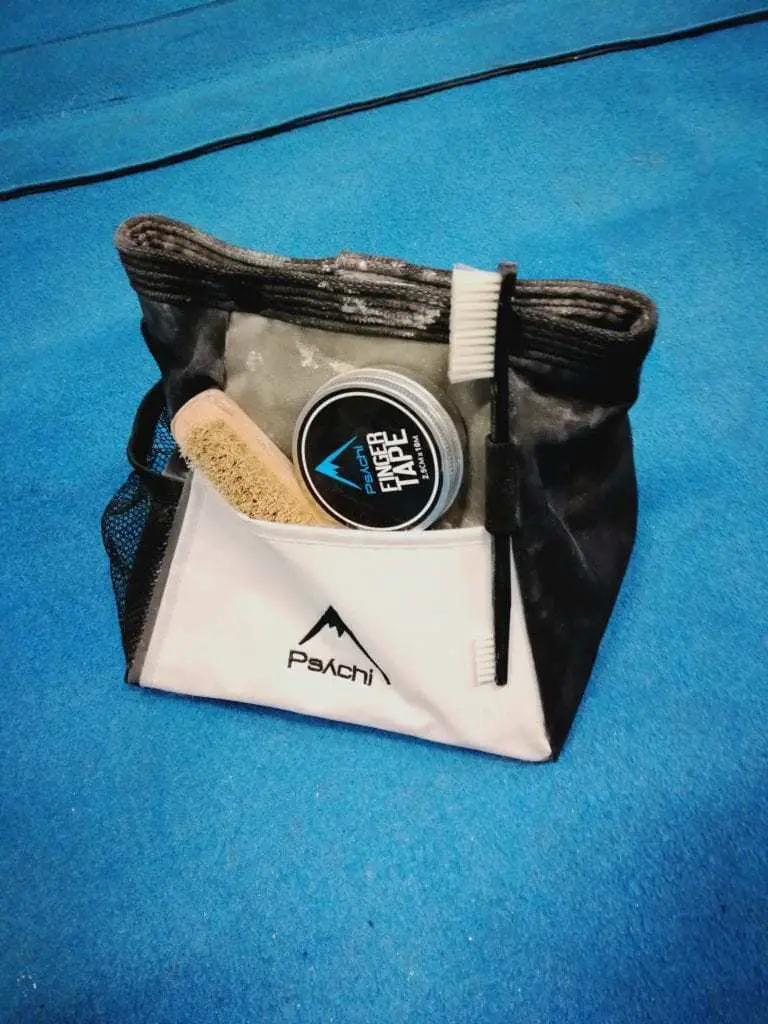
Chalk Ball
A small round ball filled with chalk.
Fingerboard aka Hangboard
A board made of wood or resin which is attached to a wall allowing the user to hang from it therefore strengthening the fingers.
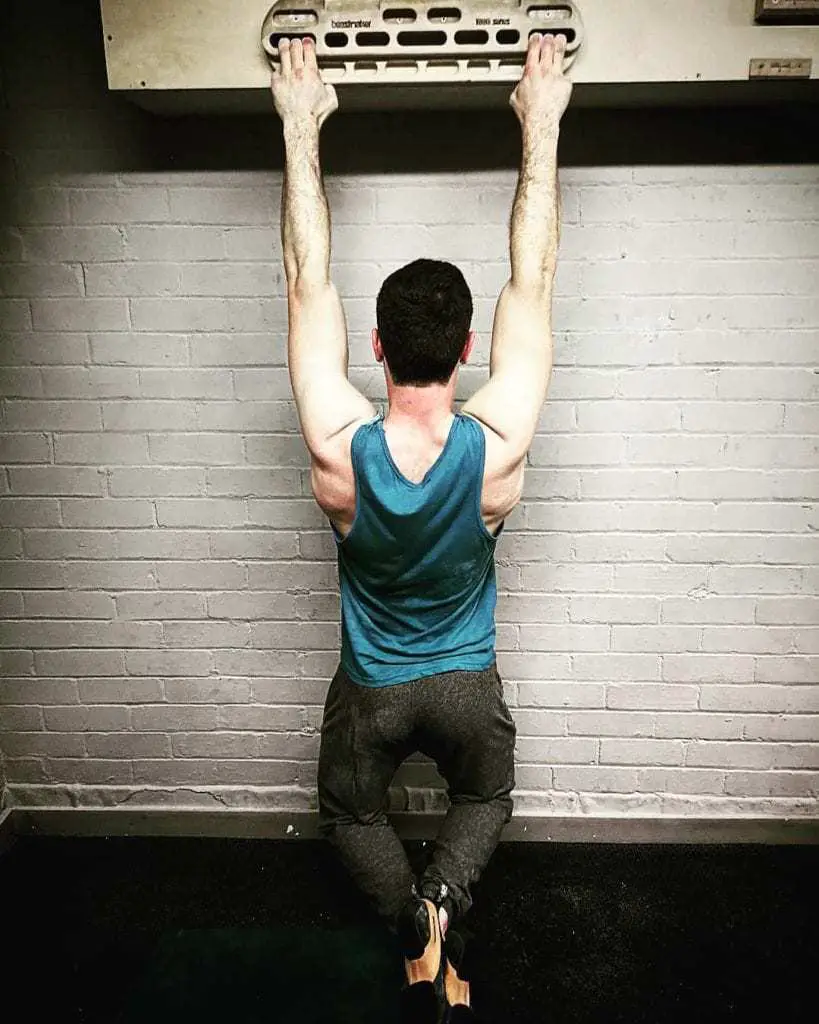
RP
A brass nut used in climbing.
Finger Tape
Tape used on fingers (and some other parts of the body such as toes) that can be used to support and protect them.
Bolt On
A climbing hold seen in indoor climbing gyms that is bolted to the wall.
Crash Pad aka Bouldering Mat
A mat used when outdoor bouldering to protect a climber by cushioning their fall.
Launch Pad
A smaller bouldering mat that is used when starting a bouldering problem.
Taco
A foam bouldering pad that can be bent in the middle for ease of transportation.
Guidebook
A book to guide an explorer around the different climbing areas and rocks available, including other information such as maps and directions.
Bomber aka Bombproof
Used when explaining equipment that is very good and/or resilient.
Observational and Other Rock Climbing Terms
Arud
Means “A rat up a drainpipe”, simplified to Arud to use after someone completes a climb surprisingly quickly.
Chunking
Figuring out a climb by climbing it in smaller sections.
Nails
A climb that is very hard for most people in your group.
Glowing Hands
Usually a term used when the hands have that burning sensation due to the nerve endings being very sensitive.
Chalking Up
Putting chalk on the hands.
Tickmark
Putting chalk on the wall to pinpoint the whereabouts of a hold that is difficult to see.
Montée Absente (pronounced Mon-tay Ab-Saunt)
A hand or toe hold within the beta that is so bad that a climber may believe it should not even be a part of the climb. Means “absent climb” in French.
Spotting
Catching or safely guiding a climber who has fallen.
Barn-door
An involuntary swing away from the wall.
Soloing
Climbing a route without using a rope or other forms of aid.
Problem
A climbing route.
Project
A problem that a climber is working towards completing that has previously been attempted and failed.
Choss
Dirt, chalk, moss or any other material on the rock wall that disrupts an ascent.
Find Your Feet
A term usually said by an on-looker when a climber isn’t using their feet correctly.
Crux
The hardest part of a climb.
Flapper
The bit of skin that flaps after it has been sliced on a hold or on the rock face.
Inside Edge
The edge on the inside of the big toe.
Sit Start aka Sit Down Start
Starting a climb by sitting down.
Cheatstone
A stone that’s used to help the climber reach the starting holds.
Sandbag
A problem that is harder than it has been graded.
Ape Index
The difference between your height and the span of your arms from the tips of your fingers.
Power Endurance
How good the climber is at completely many hard transitions and moves continuously.
Red Herring
A hold that isn’t essential and/or is there to make the climber harder because it confuses the climber into thinking it has to be used.
V Grade
An American grading system used in rock climbing.
Conditions
The temperature, weather and humidity in the area you are about to climb in.
Gardening
Cleaning greenery off the holds and/or rock face on a climb.
Powerspot
The spotter helps the climber by taking some of their weight so they can practise a move or transition with more ease.
Link Up
Creating a more difficult climb by taking different routes and combining parts of them.
Crag
An outdoor climbing or bouldering area.
Gripped
When you feel a lot of fear while climbing.
Arch
The middle part of the sole of the foot.
Aggressive Arch
When the middle part of the foot is very arched.

Body Tension
Body tension requires the core to be engaged in order to keep the climbers feet on the foot holds of a steep route.
Over Gripping
Wasting energy in the hands and forearms by holding on too hard with the hands on a hold.
Hot aches
When blood returns into a body part that was previously very cold. Imagine throwing snow balls with bare hands for 20 minutes and then going back inside your warm house, then the blood rushes back into your hands and they feel painful. This is usually felt when climbing in the freezing cold.
Pumped
When a climber’s muscles are full of blood and lactic acid therefore making the body part feel quite heavy and weak.
Reading
Studying a route – trying to figure out how to complete it.
Working
Figuring out and going over the moves on a route or problem.
Ground Up
Starting from the ground on every attempt and trying a problem without previously inspecting or analyzing it from a rope.
Chipping
Making a climbing hold easier to hold onto or creating a whole new hold. Considered bad practise in most climbing communities.
Eliminate
A problem or move mainly used in bouldering where certain holds are made off limits in order to make it harder.
Wired aka Dialled
Being able to complete a problem 100% of the time.
Golfer’s Elbow
The pushing and pulling muscles in the elbow are out of balance which can cause pain on the inside of the elbow.
Tennis Elbow
The pushing and pulling muscles in the elbow are out of balance which can cause pain on the outside of the elbow.
Grades
A hint at how hard a problem is.
Center of Gravity
The center or point where the mass of the climber is equally balanced.
Front Lever
Hanging from a bar, then raising the legs and core so the body is horizontal and therefore parallel with the floor and holding the position.
Wad
A good climber.
Squeak
Completely clean the sole of your climbing shoe.
Bunion
A lump that forms of the side of the foot due to wearing shoes that are too small for you.
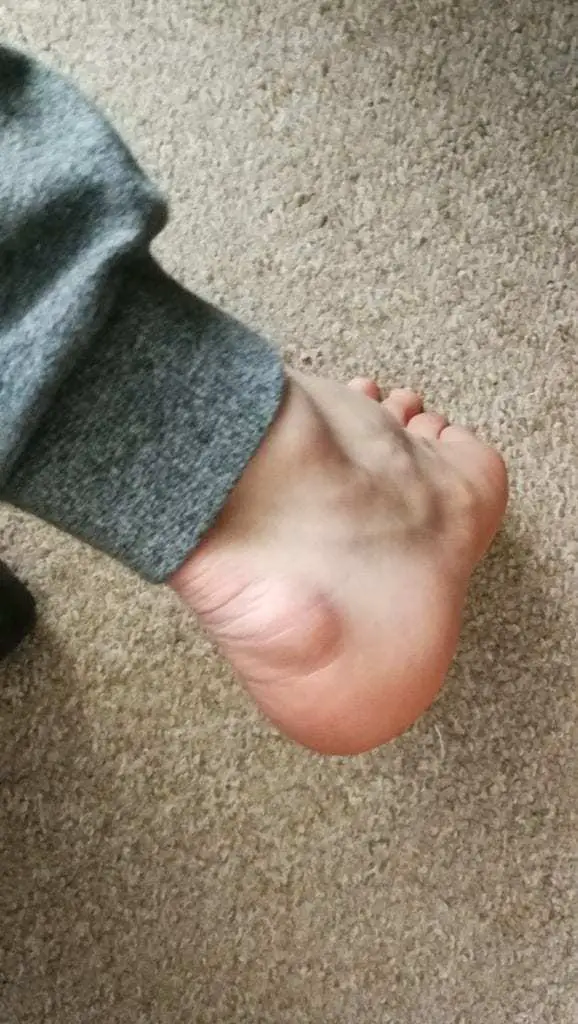
Screw On
An hold used in indoor climbing gyms that is screwed on the wall rather than bolted on.
Callouses
Skin that has hardened or thickened due to being subjected to friction – usually appearing on the hands of a climber.
Fontainebleau aka Font
A very famous bouldering area in France.
Pof aka Resin
Pine resin that is used on outdoor hand and footholds to make it easier to climb. Considered damaging to rock but is used in some areas of Fontainebleau.
Send
Successfully completing a problem.
Turning the Lip
The transition from hanging on a lip to standing on it.
Terms Used for Different Types of Rock Climbing
Bouldering
Bouldering is a type of climbing that doesn’t require a rope and is a solo activity. Unlike lead climbing (or similar) there is no one else on the wall helping you through your climb in any way (other than words of encouragement).
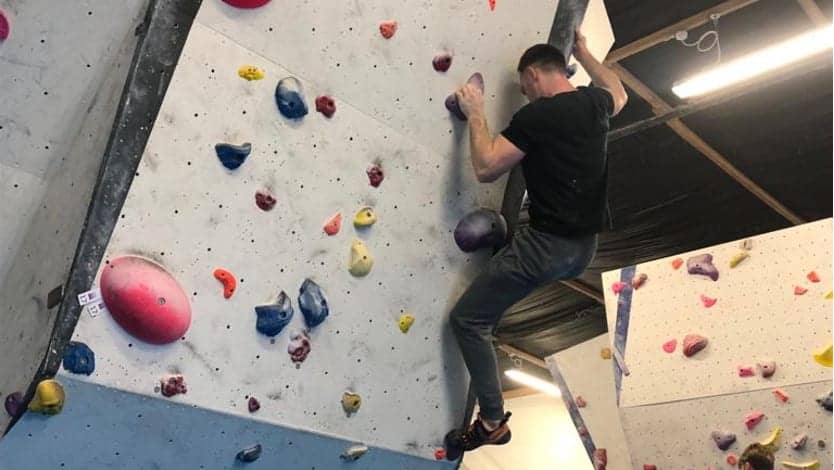
Highballing
Highballing is exactly the same as bouldering; however it’s a lot more risky due to the fact that the maximum height of a bouldering wall is considered to be around 15 feet (or 4 meters). Climbing a wall or rock that’s between 15 and 40 feet high without a rope is considered highballing.
Free-Soloing
Bouldering turns to free-soloing when the climber is climbing without ropes at a height that’s above 40 feet; either that or it’s a highball climb (between 15 and 40 feet) that’s difficult and therefore more dangerous due to the route used and techniques that have to be administered.
Lead Climbing
Lead climbing requires a leader to set the route by clipping the rope into bolts and hooks that are set firmly into the wall or rock.
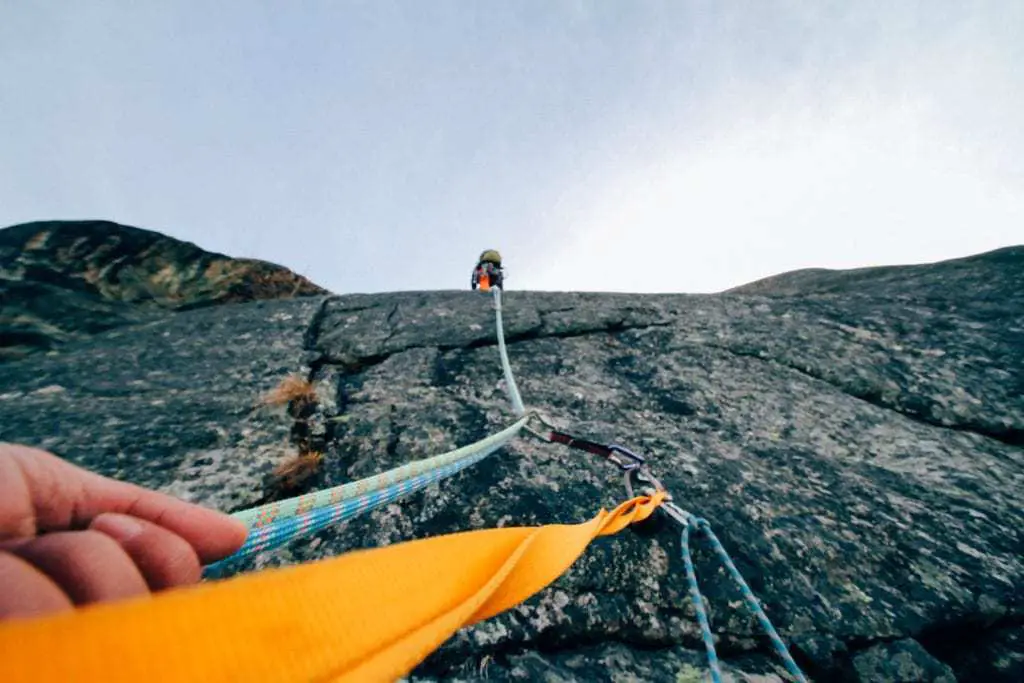
Mountaineering aka Mountain Climbing aka Alpinism (in Europe)
Similar to hiking, except it’s more physically demanding due to the different techniques that need to be used in certain situations so that you can get through a route safely. While mountaineering, you may stumble across ice, snow, and different types of rock. Because of this, different techniques and technical equipment may need to be used.
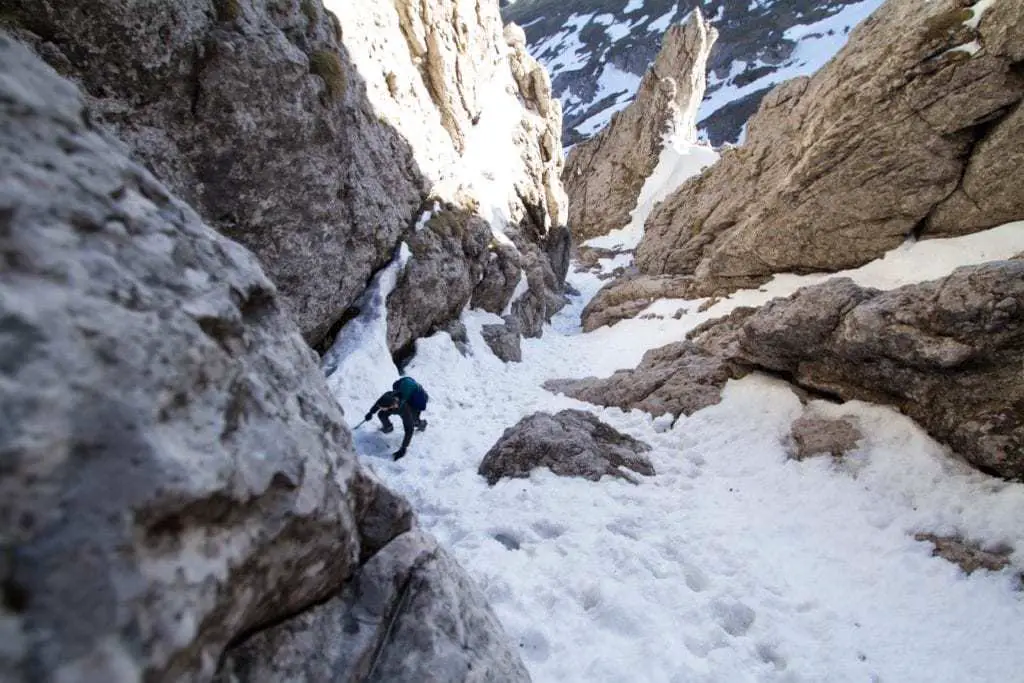
Sport Climbing
A type of lead climbing that focuses on technique, strength, cardiovascular activity, and gymnastics rather than some climbing methods which focus on adventure and risk as their major factors (for example free-soloing and mountaineering).
Traditional Climbing aka Trad Climbing
Trad climbing is another type of lead climbing. In traditional climbing, however, the anchors that are set into the wall are removed once the route has been climbed.
Aid Climbing
Aid climbing is any type of climbing that requires equipment or objects to be used into the rock which will help the climber progress up the wall or rock.
Free Climbing
Free climbing (also known as free from direct aid climbing) describes any type of climbing that does not use climbing equipment to help the climber progress in their climb; however with free climbing, equipment is allowed purely for safety reasons.
Rope Soloing
Rope soloing (also known as roped solo climbing) is a type of climbing which is done without a partner but a rope is used for protection.
Multi Pitch Climbing
Multi pitch climbing is any form of climbing that has belay stations for the climber to stop at on different areas of the climbing route.
Deep Water Climbing aka Deep Water Soloing aka Psicobloc
Deep water climbing is where the climber uses the water below as the “safety net” in case they fall.
Ice Climbing
Ice climbing usually uses picks, crampons, ropes and protective gear while the climber climbs frozen water falls, cliffs, frozen slabs and other similar terrains.
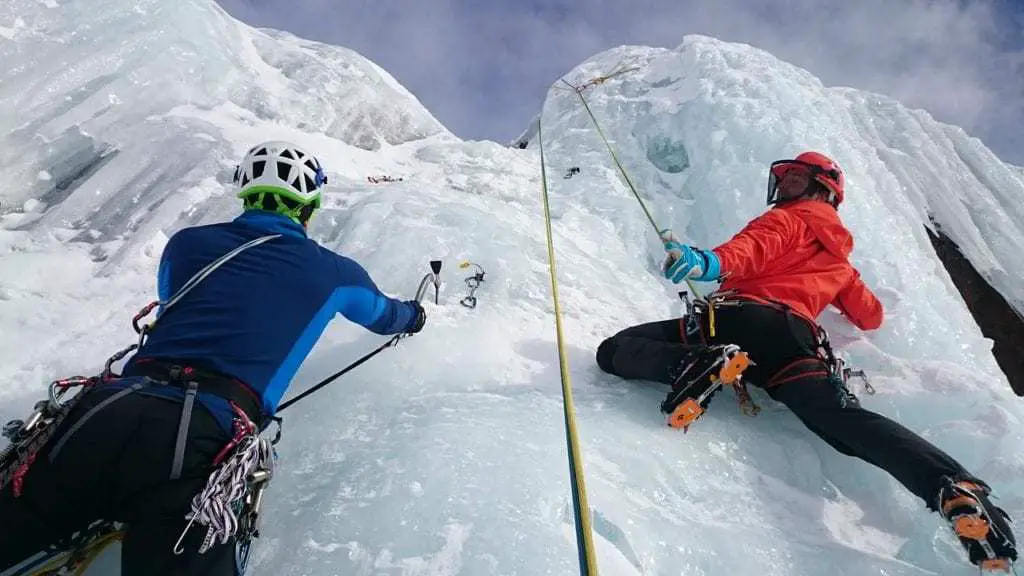
Terms for Different Types of Rock Used When Climbing
Igneous Rock
Igneous rock is formed when liquid magma cools.
Sedimentary Rock
Sedimentary rock is created when the accumulation of tiny minerals and sediment is very tightly compacted.
Metamorphic Rock
A type of rock that was once very different and has been changed from its original igneous or sedimentary characteristics when a large amount of heat, pressure, or hot mineral-rich fluids (or a combination of the three) have been applied.
Gabbro
An igneous rock that’s coarse grained.
Basalt
A form of igneous rock and can either be very good to climb on or it can provide climbs that aren’t suitable and can actually be quite dangerous. The difference between the two is found in the chemical composition of the rock and/or the weathering that the rock has been through.
Granite
A rough, igneous rock popular with climbers.
Quartzite
When intense heat or pressure is applied to sandstone, quartzite is the outcome.
Gritstone
A type of sandstone that’s hard and coarse-grained.
Limestone
A sedimentary rock formed over many years from the build-up of shell, coral, algal, and fecal debris.
Sandstone
A sedimentary rock made up of sand-sized minerals, rock and/or organic material.
Monzonite
A granular igneous rock.
Syenite
A coarse-grained igneous rock.
Tufa
A type of limestone created when carbonate minerals precipitate out of ambient temperature water.
